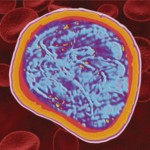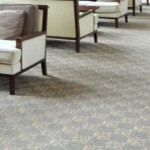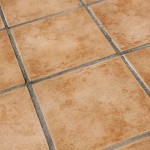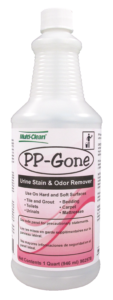How to Remove Urine Stains and Urine Odors
Nothing smells worse than urine that has soaked into porous hard and soft surfaces. Urine accidents can also leave ugly yellow stains on bedding, mattresses, clothing, upholstery, and carpets. Understanding the cause of urine odors and stains can guide you to the right chemistry capable of destroying the smell and the stain.
More than 50% of cleanliness complaints are due to malodors, and urine odors are at the top of list of objectionable odor complaints. These complaints can be “business killers” and leave an impression that a facility is unclean.
85% of adults would not return to a restaurant’s unclean or unsanitary restroom.(1)
50% of restaurant-goers would spread the word to family and friend about a restaurants unsanitary conditions.(2)
Read on to learn how to tackle urine odors and stains on virtually any surface.
The Science behind the Smell
That foul smell we equate with urine is actually not what urine smells like. The odor comes from odor causing bacteria and uric acid crystals left behind from a urine accident. Bacteria use urine residue as a food source by releasing enzymes to break the urine down. This microbial process releases foul smelling by-products creating that “urine odor”. The uric acid crystals often remain trapped in surfaces and release an ammonia like odor further complicating the urine odor problem.
A Smell that Keeps Coming Back
After best efforts to remove urine odors and stains, the urine smell may quickly return under humid conditions or when the surface is wetted. This activates the uric acid crystals and the previously dormant bacteria to start doing their thing again. This is what is so frustrating about urine stains and odors, you think you got it only to find out you really didn’t.
Examples of Problems
Soft surfaces are particularly challenging as urine can soak deep into surfaces. A urine accident on a carpet can
easily soak through the carpet backing into a pad or sub-floor. Urine can penetrate deeply into a mattress making the process of removing the odor extremely difficult. Upholstered furniture is another example of a soft surface that can result in deep penetration of urine resulting in removal challenges.
Hard surfaces can also be a problem. Grouted tile is common in bathrooms. The grout is porous creating great hiding places for urine residues and the resulting odors. Surfaces around toilets not properly caulked can also be great hiding places.
A Stubborn Yellow Stain
Urine has pigments that give it a characteristic yellow color. The primary pigment called “urochrome” is responsible for the yellow coloration can be difficult to get out when set in fabrics or carpet.
Getting the smell and the stain out
One might assume a disinfectant applied to the surface might do the job. While disinfectants may be able to kill some or all of  the bacteria, they have limited effect on the uric acid crystals, so the smell remains. Another approach is to use a microbial “Enzyme” cleaner. These can be effective, but also require specific techniques, have limited effect on uric acid crystals, and are incompatible with disinfectants.
the bacteria, they have limited effect on the uric acid crystals, so the smell remains. Another approach is to use a microbial “Enzyme” cleaner. These can be effective, but also require specific techniques, have limited effect on uric acid crystals, and are incompatible with disinfectants.
What type of chemistry in a urine odor & stain remover works best?
- pH matters: a mildly acidic pH is necessary to dissolve the uric acid crystals and urochrome pigments.
- Attacking bacteria: to achieve success, the odor causing bacteria must be destroyed. Hydrogen peroxide is a safe and effective way to destroy bacterial odors if used at the right level.
- Surface safe: hydrogen peroxide is also great at removing stains without harming surfaces, including soft surfaces like mattresses, upholstery, carpeting and clothing.
- Deep penetration: surfactants are necessary to help the hydrogen peroxide penetrate deeply into soft or porous surfaces to get at the problem. These surfactants also help lift stains out of surfaces.
Multi-Clean has developed a product with the key properties to remove urine odors & stains on hard & soft surfaces.
Multi-Clean PP-Gone Urine Stain & Odor Remover
Mildly acidic pH of 3-4 helps dissolve uric acid crystals and yellow stains.
Hydrogen peroxide in the range of 2-4% destroys odor causing bacteria.
Surfactants allow deep penetration into thick soft surfaces like mattresses, upholstery, and carpet.
Hydrogen peroxide helps safely remove stains from soft surfaces.
More information on Multi-Clean PP-Gone Urine Stain & Odor Remover.
Compare to Clorox Urine Remover *
Tips & Tricks for Urine Odors and Stains
- For mattresses, apply generously to allow penetration, repeat process up to 2 times. Wait 2-5 minutes after each application. Blot area with a white towel to remove any visible stains and excess moisture. You can also extract with a carpet extractor or a wet dry vacuum.
- For upholstery, apply generously, after 2-5 minutes, wipe stain area with a microfiber cloth, then blot with a white towel OR extract with a carpet extractor (or wet-dry vacuum).
- For carpet, consider using a carpet syringe to inject PP-Gone under the carpet backing. The urine residue under the carpet can be 2-3 times the diameter of the stain on the surface. For the surface, apply, then wait 2-5 minutes before agitating with a microfiber cloth or soft brush. Blot or extract stain.
- In bathrooms, after cleaning, spray PP-Gone around the base of toilets and around urinals (sides, bottom, floor) and let air dry.
Visit us at www.multi-clean.com
*Clorox Urine Remover is a registered trademark of the Clorox Company.
(1) Cintas Online Survey Shows Majority of Americans Value Workplace Restroom Care, March 2020.
(2) SCA Tissue North America, found that the cleanliness of restaurant bathrooms is a key factor in repeat business, October 2008.




So do you just spray on and leave when apply to carpet or upholstery
When dry is it pet safe.?
Yes, you apply it to the area. For carpet or plush upholstery, it helps to work it in to the fibers with a soft cloth or soft brush. The hydrogen peroxide is perfectly pet safe, after doing its job, it breaks down to oxygen and water.
You for answering. So for best results use a wash rag after spraying in.
Sounds like a great product for pet owners to have on hand! There’s nothing worse than thinking you’ve cleaned the “accident” up, only to have the smell come back when the weather heats up or is humid!